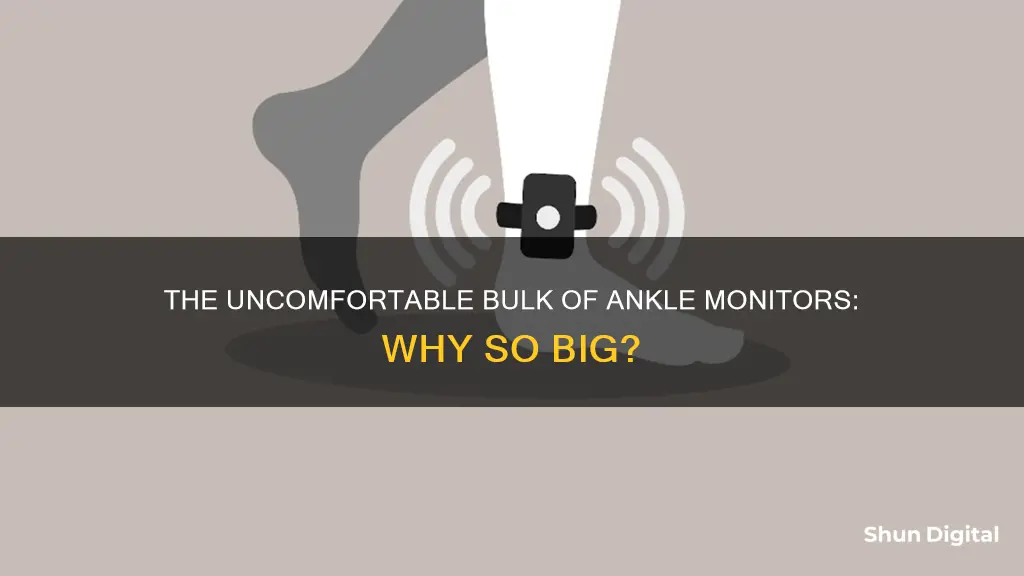
Ankle monitors are electronic devices used to track an individual's location and movements, typically as a condition of bail, parole, or probation. They are often seen as a way to help certain people charged with or convicted of crimes avoid jail time while still allowing them to go about their daily lives. While the technology has evolved over the years, with GPS-based systems replacing the older landline phone-based methods, one aspect that has remained constant is the size of the monitors. This is likely due to the need to accommodate the required hardware, batteries, and, in some cases, alcohol sensors. The bulkiness of the device can cause discomfort and limit certain activities, as seen in the case of a snowboarder who struggled to fit the monitor into their boot.
| Characteristics | Values |
|---|---|
| Size | Roughly the size of a pack of cigarettes |
| Purpose | Monitor people who have been charged with crimes, are on bail, or are on house arrest |
| Functionality | Sends a signal every 60 seconds to a receiver attached to a home telephone |
| Range | 45.72 meters from the home telephone |
| Cost | $5 a day, or hundreds of dollars per month |
What You'll Learn

Cost of ankle monitors
The cost of ankle monitors is a controversial topic. In most states, individuals on electronic monitoring (EM) are required to pay daily, weekly, or monthly fees, or a flat rate to be tracked, monitored, and have their liberty curtailed. The cost of these fees often falls on the person wearing the monitor, who may be on a work release program or pretrial release. The fees can be extremely high, with some jurisdictions charging several thousand dollars, such as in Ramsey County, Minnesota, where prisoners must pay $2,275 to participate in the release program.
The high cost of ankle monitors can create a financial burden for those who are required to wear them, especially if they are also trying to support their family or pay off debts. This has led to criticism of the practice, with some arguing that it exploits those who are already struggling and could even push them to reoffend. In addition, the lack of transparency and complicated nature of these fees make it difficult for individuals to understand the true cost of these devices.
On the other hand, some argue that the person being monitored has the option to refuse the ankle monitor and stay incarcerated, or that the cost of the monitor is justified as it is a consequence of their actions. Additionally, the cost of the monitor may be offset by the savings achieved through reduced prison populations.
The cost of ankle monitors is not just financial but also includes the loss of privacy and freedom for those who wear them. The monitors can be uncomfortable and restrictive, impacting the wearer's ability to participate in certain activities.
Overall, the cost of ankle monitors is a complex issue that involves financial, social, and ethical considerations. While they can provide an alternative to incarceration, the cost of these devices and the associated fees may create additional challenges for those trying to reintegrate into society.
Troubleshooting ASUS Zen AIO Monitor Sleep Issues
You may want to see also

Effectiveness of ankle monitors
Ankle monitors have been used as a way to keep people out of jail while they await trial. They are also used to monitor people who have been released from jail. The use of ankle monitors has been on the rise in recent years, with an increasing number of people being placed on GPS ankle monitoring systems.
The effectiveness of ankle monitors in ensuring public safety has been questioned by critics. There have been several instances where individuals on ankle monitoring have committed further crimes, including violent offences. In one case, Daniel Riley, who was on a GPS ankle monitor while awaiting trial for armed robbery, caused a crash that led to a young volleyball player losing her legs. In another instance, a teenager in Charlotte, North Carolina, was charged with raping and robbing a woman just days after his ankle monitor battery died.
Proponents of ankle monitoring argue that it is a successful alternative to mass incarceration, helping to reduce jail populations. For example, the City of St. Louis' jail population decreased by more than 60% over a five-year period, partly due to the use of ankle monitors. However, critics argue that the technology is not a replacement for in-person supervision services and that it can give a false sense of security.
Ankle monitors have also been criticised for their cost, which is often passed on to the wearer. This can amount to hundreds of dollars per month, and in some cases, several thousand dollars. This has been described as "unproductive" by critics, who argue that it can lead people into worse situations.
While ankle monitors can provide a level of supervision and monitoring, their effectiveness in ensuring public safety and preventing reoffending is questionable. The success of ankle monitors depends on several factors, including proper monitoring, timely response to violations, and ensuring individuals can afford the associated costs. Without these measures in place, ankle monitors may not be an effective tool for criminal justice and public safety.
Activity Monitor Data Usage: A 24-Hour Watch
You may want to see also

Who pays for ankle monitors?
In the United States, the government pays for ankle monitors for some individuals in the federal criminal justice system and for tens of thousands of immigrants supervised by Immigration and Customs Enforcement. However, states and cities, which bear around 90% of the costs of jails and prisons, typically pass the financial burden of ankle monitors onto those who wear them.
In most states, individuals are required to pay daily, weekly, or monthly fees for their ankle monitors, and failure to pay can result in extended supervision, additional fees, or even jail time. This has led to concerns about defendants being driven into debt and individuals being incarcerated due to their inability to pay rather than as a result of criminal activity.
As of 2014, with the exception of Hawaii, every state required individuals to pay at least a portion of the costs associated with GPS monitoring. The amount charged can vary, with private companies charging higher rates than government agencies. For example, cities often pay contractors $2 to $3 per day for monitoring equipment and services, while private companies like Emass charge defendants up to $10 per day.
The high cost of ankle monitors can pose a significant financial burden, particularly for those who cannot afford bail and may already be facing economic challenges. This has raised questions about the fairness of the system and the potential for discrimination based on race and poverty.
Connecting Your MacBook to an External Display
You may want to see also

Ankle monitors for non-criminals
Ankle monitors are often associated with criminal justice, with law enforcement using them to monitor people's movements and locations. However, it is important to note that ankle monitors are not always worn by criminals or those awaiting trial. In some cases, individuals who are not involved in the criminal justice system may be required to wear ankle monitors for various reasons.
One example of non-criminal use is in the medical field. A person recovering from surgery or dealing with a medical condition may be required to wear an ankle monitor as part of their treatment. For instance, a person with an injury or surgery on their ankle may need to wear a monitor to stimulate bone growth and aid in the healing process, as in the case of Mary Ann, who wore an ankle monitor for three hours daily after experiencing complications from ankle surgery.
Ankle monitors have also been used in the context of public health and safety. During the COVID-19 pandemic, students at Eatonville High School in Washington were required to wear ankle monitors to facilitate contact tracing and encourage social distancing. This use of ankle monitors sparked controversy, with some parents expressing outrage and feeling that their rights were being infringed upon.
While ankle monitors are typically associated with criminal justice, it is important to recognize that they can also be utilized in non-criminal contexts, such as medical treatment and public health initiatives. However, the use of ankle monitors, even for non-criminals, raises important questions about privacy, consent, and the potential for overreach by authorities.
As technology advances, it is likely that we will see a wider range of applications for ankle monitors and similar tracking devices. While these devices can serve a legitimate purpose, it is crucial to balance their use with ethical considerations and respect for individual rights and liberties.
Enhance Productivity: Dual Monitors via HDMI Port
You may want to see also

History of ankle monitors
The idea of electronic tagging first emerged in the 1960s, when social psychology students at Harvard developed a system to monitor the movements of juvenile offenders and encourage them to show up to places on time. The technology was first created for positive reinforcement, with the intention of rewarding offenders for good behaviour. The students, twin brothers Robert and Kirk Gable, created a system in which offenders would wear radio devices that communicated their location. The rewards were simple—a free haircut, pizza, or concert tickets.
In the 1970s, the idea of electronic monitoring gained traction, inspired by a Spider-Man comic book series in which the evil Kingpin attaches a tracking device to Spider-Man. Judge Jack Love from Bernalillo County, New Mexico, saw the series and approached an engineer about producing a tracking device for low-level criminals. He became one of the first judges to use his authority to mandate that offenders wear location-monitoring devices. The engineer he partnered with, Michael Goss, referred to the device as "electronic handcuffs" and a "goldmine". Goss's company commercialised the ankle monitor and came up with the idea of charging the user for the cost of the device and its usage, a practice that continues today.
The first ankle monitors hit the market in 1983 and were roughly the size of a pack of cigarettes. They communicated with a receiver attached to a home telephone and sent a signal every 60 seconds. If the device was found to be out of range, an alert would be triggered. Judge Love imposed home curfews on three offenders who had been sentenced to probation and trialled Goss's ankle monitor on them. While two of the three re-offended, the goal of home confinement was satisfied, and the idea of electronic monitoring spread throughout the country.
Today, the technology behind ankle monitors has become much more sophisticated, using GPS and cell tower signals to pinpoint an offender's location. On any given day, at least 131,000 people in the United States are wearing court-ordered ankle bracelets, and this number is expected to grow to 282,000 by 2025.
Removing Emission Monitors: PCM Reset for Performance
You may want to see also
Frequently asked questions
Ankle monitors are big because they contain a lot of technology. They have GPS tracking and can monitor whether the wearer has consumed alcohol.
Ankle monitors use GPS to track the wearer's location. They can also detect alcohol in the wearer's sweat. If the wearer goes outside of a certain area or consumes alcohol, the monitor will notify the relevant authorities.
People who are out on bail or probation often have to wear ankle monitors. People who are under house arrest or participating in electronic monitoring programs may also have to wear them.
In the US, people on bail often have to pay hundreds of dollars per month for their ankle monitors. In some places, the cost can be several thousand dollars.







